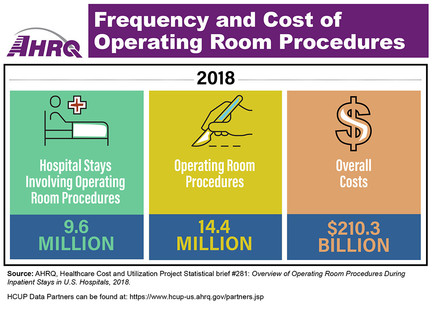| November 30, Issue #791  Access more data on this topic in the associated statistical brief, plus additional AHRQ data infographics.  Patients with retail medications to treat opioid use disorders spent on average 3.4 times more for out-of-pocket prescriptions than the rest of the U.S. population, according to an AHRQ-study published in the Journal of Substance Abuse and Treatment. Researchers used 2011-2017 data from AHRQ's Medical Expenditure Panel Survey to estimate the financial costs faced by the population receiving buprenorphine or naltrexone, the two most common medications available from retail pharmacies to treat opioid use disorders. They found that about 19 percent of patients paid entirely out of pocket for their retail prescriptions for opioid use disorders. In addition, out-of-pocket expenses on office visits for patients being treated for opioid use disorders cost an average of $587.09 per year, which is 3.5 times higher than for the rest of the population. Researchers concluded that future policies that expand insurance and address out-of-pocket spending could increase access to treatment, which also includes office visits and other expenses, for patients with opioid use disorders. Access the abstract. |  AHRQ has released an updated Chartbook on Rural Healthcare that shows that people in rural areas face difficulty getting timely, high-quality, affordable healthcare. Almost 60 million Americans live in rural communities, often some distance from healthcare resources, which can add to the burden of accessing care. The new chartbook is based on data from AHRQ's most recent National Healthcare Quality and Disparities Report, an annual publication that uses quality measures to assess the healthcare system's strengths and weaknesses, as well as disparities. The chartbook shows that although about half of quality measures have improved for residents of rural areas, healthcare access and quality tend to be worse in rural areas than in suburbs. | Respirators, including N95s and elastomeric respirators, help protect healthcare workers from COVID-19 and other airborne viruses. Making sure these respirators fit the face properly is essential to maximizing their effectiveness. A new AHRQ guide defines respirator fit testing and explains why it's important, how it works and how often nursing home staff members should get a respirator fit test. Access more resources from AHRQ for preventing the spread of COVID-19 in nursing homes. AHRQ's Patient Safety Network (PSNet) highlights journal articles, books and tools related to patient safety. Articles featured this week include: Review additional new publications in PSNet's current issue or access recent cases and commentaries in AHRQ's WebM&M (Morbidity and Mortality Rounds on the Web). | AHRQ in the Professional Literature Patient-reported outcomes through 5 years for active surveillance, surgery, brachytherapy, or external beam radiation with or without androgen deprivation therapy for localized prostate cancer. Hoffman KE, Penson DF, Zhao Z, et al. JAMA. 2020 Jan 14;323(2):149-63. Access the abstract on PubMed®. Trends in diagnostic imaging utilization among Medicare and commercially insured adults from 2003 through 2016. Hong AS, Levin D, Parker L, et al. Radiology. 2020 Feb;294(2):342-50. Epub 2019 Dec 31. Access the abstract on PubMed®. Significant hospitalization cost savings to the payer with a pharmacist-led mobile health intervention to improve medication safety in kidney transplant recipients. Taber DJ, Fleming JN, Su Z, et al. Am J Transplant. 2021 Oct;21(10):3428-35. Epub 2021 Jul 14. Access the abstract on PubMed®. Usefulness of child HCAHPS survey data for improving inpatient pediatric care experiences. Quigley DD, Slaughter ME, Gidengil C, et al. Hosp Pediatr. 2021 Oct;11(10):e199-e214. Epub 2021 Sep 21. Access the abstract on PubMed®. Impact of a pilot community pharmacy system redesign on reducing over-the-counter medication misuse in older adults. Gilson AM, Stone JA, Morris AO, et al. J Am Pharm Assoc (2003). 2021 Sep-Oct;61(5):555-64. Epub 2021 Apr 15. Access the abstract on PubMed®. Failure mode and effect analysis: engineering safer neurocritical care transitions. Chilakamarri P, Finn EB, Sather J, et al. Neurocrit Care. 2021 Aug;35(1):232-40. Epub 2021 Jan 5. Access the abstract on PubMed®. Established evidence-based treatment guidelines help mitigate disparities in quality of emergency care. Trent SA, George N, Havranek EP, et al. Acad Emerg Med. 2021 Sep;28(9):1051-60. Epub 2021 Jun 28. Access the abstract on PubMed®. Impact of technology-based interventions on patient-reported outcomes in asthma: a systematic review. Doshi H, Hsia B, Shahani J, et al. J Allergy Clin Immunol Pract. 2021 Jun;9(6):2336-41. Epub 2021 Feb 4. Access the abstract on PubMed®. Contact Information For comments or questions about AHRQ News Now, contact Bruce Seeman, (301) 427-1998 or Bruce.Seeman@ahrq.hhs.gov. |






No comments:
Post a Comment